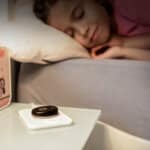How Do I Keep My Child’s Audio Processor On?

When children get cochlear implants, it’s important that they wear their audio processors regularly throughout their waking hours. Research tells us that wearing time is linked to communication outcomes.
One of the biggest concerns for parents and caregivers is how to keep their child’s audio processor on. In this blog post, we’ll provide you with tips that can help you get your child to wear their hearing implant audio processor as much as possible.
For Babies and Small Children
1. De-Sensitize Them
There are many children who dislike any form of contact with their head or hair. In turn, this may create a reluctance to wearing audio processors. The first step towards de-sensitization is that the audio processor becomes just as normal as wearing a pair of shoes. Here is what you can do:
- Keep the audio processor nearby during the day so it becomes part of the child’s everyday world to prevent children from becoming anxious about it.
- If your child feels safe, let them play with the processor. You can also ‘take it for a ride’ on a toy car or train.
- Try to put the audio processor on your child while it’s switched off. In case your child uses a soft band to keep the device in place, try using the band without the device. You can start to introduce the device once your child accepts the headband.
Remember, de-sensitization requires time and effort. It doesn’t happen overnight. So don’t give up!
2. Ensure That the Audio Processor Is Comfortable and Secure
- If you notice that your child takes off their processor when hearing loud sounds or blinks frequently while hearing sounds around them, contact their audiologist as soon as possible.
- For children who are very active, speak with your audiologist about available audio processor retention options (head bands, hair clips etc.). These will help secure the processor in place.
- Custom caps with knit and athletic mesh are also an option that help babies to keep their hands away from hearing devices.
3. Increase Your Child’s Wear Time Gradually
- When your child pulls the processor off repeatedly, take a break and try again later when you both feel more relaxed.
- Gradually increase the duration of wearing time as soon as possible up to full time use.
- Make the experience positive.
4. Make It Part of Their Daily Routine
Integrate the audio processor into your child’s daily dressing and undressing routine. Continue to encourage your child to wear the audio processor as soon as they wake up and remove them just before they go to bed. There is so much rich language and communication in the bedtime routine we don’t want them to miss!
5. Use Distraction Techniques
Try to make a hearing implant toy box. Only give it to your child while putting their audio processor on. Using this distraction technique keeps children busy. The toys should be exciting and motivating. Try to limit the exposure to these toys throughout the day. You can try to rotate the toys inside the box to keep the excitement going.
6. Get Your Child Excited About Their Hearing Implant
Decorating the audio processor can be exciting for younger kids. If your child wants their processor to be colorful, contact your audiologist to find out about covers and accessories.
Learn more about how to customize your child’s audio processor here. There are stickers, charms, decorative clips which are available on the market to decorate hearing devices. When decorating, don’t cover anything that needs to stay uncovered, such as the microphones. Check with your audiologist if you’re unsure.
7. Attend Regular Audiology Appointments
It could be that your child is struggling to wear their processor because of the way it has been programmed. Attend all audiological appointments to ensure your child’s implant is programmed correctly.
8. Never Give Up
Even though it may seem like things will never get easier, they will! As a parent, just aim to keep those audio processors on little bit longer than the day before. Before you know it, your child will soon be asking you to put them on.
9. Reach Out to Other Parents
Other parents have faced similar challenges. They might have some other tips and tricks that worked for them that might help you as well. Talk to our Hearpeers mentors for help and advice.
Older Children and Teenagers
When children reach adolescence, the acceptance of their peers has a strong influence on them. . The reason most older children reject their hearing implant is that they want to fit in. Here are few tips that may help:
1. Find the Reason They Don’t Want to Wear Their Processor
Find out how your child feels about hearing loss and hearing implants. Give them the opportunity to express how they feel about wearing their hearing device. Children who reject their hearing device may do so for a variety of reasons: they don’t feel well with the implant, being teased, or bullied, or they feel as if they don’t fit in. It is important to address this reason.
2. Self-Esteem and Fitting In
Self-esteem and confidence are big contributors in a mainstream setting. Children with hearing loss are at risk of rejecting their hearing implant if they don’t have a strong, positive self-esteem. This can be addressed by teaching children about their hearing loss, how to talk about their hearing loss, confidence, and resilience right from the beginning. Read more about how to build confidence in children with hearing loss.
3. Explain the Importance of Wearing It
In older kids, it is important to explain why it is important for them to wear their audio processor, so they understand the value. Discuss with them:
- The effect of not hearing well
- How wearing it promotes their quality of life and relationships
- The educational benefits
- Best listening possibilities and learning opportunities
- Help in speech understanding, sound clarity, and communication skills

4. Reach Out to Other Cochlear Implant Users
Children of this age will benefit greatly from being connected to peers who also wear hearing implants. Also, exposure to older role models such as Hearpeers who use hearing implants and advocate for themselves will model positive self-confidence.
5. Maintain a Positive Attitude
- Express a positive attitude towards your child’s hearing loss and use of hearing implants.
- Use positive language when answering your child’s questions and doubts.
- Teach your children strategies to deal with challenging situations. It is important to make them aware of their needs and teach them how to communicate these to others. This ability to speak up for themselves and get what they want will make them more independent. Teaching them self-advocacy skills is very important in challenging situations. Learn more about self-advocacy tips here.
Download a printable version of these recommendations here.
Thanks for your message. We will reply as soon as possible.
Send us a message
Field is required
John Doe
Field is required
name@mail.com
Field is required
What do you think?
The content on this website is for general informational purposes only and should not be taken as medical advice. Please contact your doctor or hearing specialist to learn what type of hearing solution is suitable for your specific needs. Not all products, features, or indications shown are approved in all countries.
Yen, Ha
June 18, 2023
I love the tips and Tricks, that is very practical and helpful. Thank a lot



Conversation
1 Comment